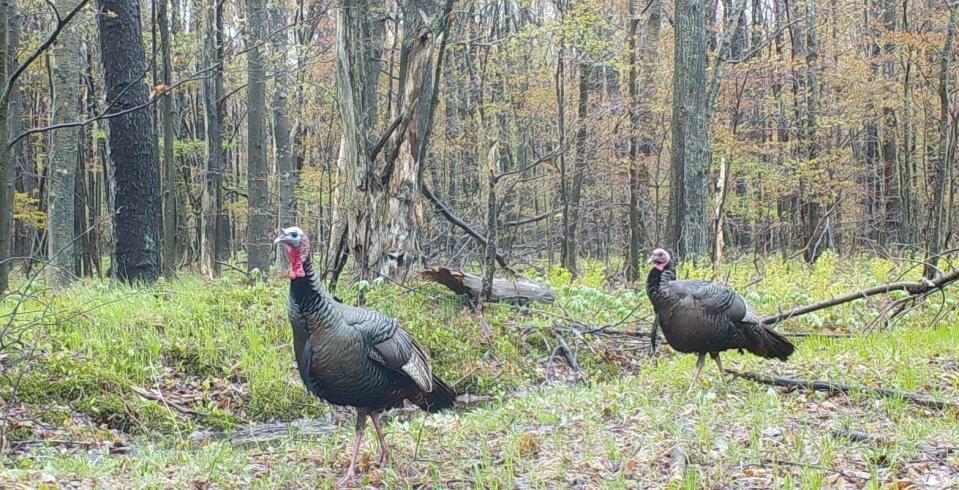How to discern turkey calls
When many of us hear a gobble while hunting, we might think, "Finally! Sure enough, that was a gobble!"
And then usually, out comes the box, pot, or mouth call and we make a call, replicating a hen to see if that bird will answer us back.
And if he does, the hunt is on.
But some of the more experienced gobbler hunters I’ve known can actually access a number of the gobbler's qualities by the sound of the old thunder chicken's roar.
For instance, experienced hunters will often remark whether the sound of a gobble is in fact coming from a jake, a yearling tom, a two-year old, or a mature bird.
I've been with hunters who will say, "Hear that? That's a two-year-old."
Pretty amazing indeed, to be able to figure the age of a bird by just the sound of its gobble.
But then again, verification is usually problematical when we never even catch a glimpse of the gobbling tom.

Personally, just my two cents, I think gobblers have different voices like people. Some are deep and booming, others have a higher pitch. And the acoustics created by the terrain, the ridge or hollow has a lot to do with the pitch and timbre of the gobble, too.
A gobble can sound far away, muffled by deep brush filling a hollow, but then again sound very close when a gobble rings through open pole timber.
Complicating determinations occurs when there is more than one bird gobbling.
Seems like the pairing up of toms is more common nowadays than it was back in the 70's and 80's when turkey hunting in the spring of the year was a young sport.
Back in those days, when I called in a tom, the bird was rarely hooked up with another gobbler. But nowadays, this grouping of toms, often two and sometimes three, seems more like the rule than the exception.
Grouped up toms often gobble at the same time, or syncopated, where one gobble sets off the other, making an age determination beyond all but the most experienced turkey hunter's ability.
Last season I called in a bird and was surprised to see two other younger toms, running with the old dominant bird, but a bit off to the side. Actually, one of the younger long-beards, probably a two-year-old, ran past my decoys first. I could see the old tom hanging back, displaying, that is, strutting, with a fanned-out tail and drooped wings, an absolutely beautiful sight in the bright mid-morning sunlight. Luckily my patience was rewarded on that hunt.
Seems like some toms are so dominant that they repress the gobbling of the other, less dominant birds. I have seen a fully fanned out gobbler in a field try to chase off the younger, smaller and quicker jakes and two-year-olds with no luck.
If the young birds got too close to the old strutter’s hens, he would run at them, but only so far. Because when he looked back at the hens, another one of the jakes would start to move in. And he would have to run back to the feeding hens to protect his gals from the younger birds advances.
Quite the show.
He rarely answered my calls, though he would once in a while. The young toms never gobbled on that day. His answers were the type of gobble I would call "an obligatory gobble." There is not a lot of demand or heart in that kind of gobble. Just more like, "Ok, here I am. You come to me because I am not moving."
Sometimes gobblers come in on the run. But that also seems to be rarer these days than when we started calling toms.
So when I hear a tom sound off, I immediately look around for a good setup spot, where I can have a good view, optimal gun swing, and my back is protected, preferably against an old tree or stump.
Then, I set up my decoys, and the dueling starts with turkey calls.
The first call, when all is ready, is all-important.
And that first answer tells us not only where the bird is, how he is moving, and his interest level.

Some toms will gobble, gobble, gobble, incessantly double-gobbling, triple-gobbling, once they get worked up, but still won't come in.
Why?
We think, "Man, he was hot … sounded like he was coming in!"
Usually these stubborn, reticent birds are hooked up with hens.
The females are busy with their routine. “And a bird in the hand …” So the tom will not leave them.
Once in a while, when we get really lucky, we can call in the hens. And when the gals come in, the old boy often is in tow, following right behind, strutting all the way in.
Then there is the other extreme, the silent ones.
You know what they always say ... "watch out for the silent ones."
Especially poignant when turkey hunting.
Often those silent toms slip in unannounced.
Just the slightest turn of the head, or a shift of the gun is all it takes to hear the worst sound a turkey hunter can hear ... the sharp "putt, putt, putt" alarm sounds from a spooked tom, running off through the woods.
A far cry from a gobble.
Oak Duke writes a weekly column appearing on the Outdoors page of The Spectator.
This article originally appeared on The Evening Tribune: How to discern turkey calls

